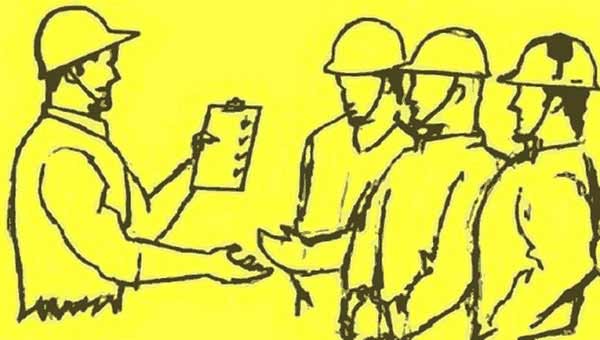“Toolbox talks can be a particularly useful way of ensuring a common understanding of how even the most basic tasks are to be carried out. If you don’t already conduct toolbox talks on your vessel, give it a go! You will be surprised at how effective these are at improving risk awareness and encouraging better, safer ways of working.”
-Steve Clinch, Chief Inspector of Marine Accidents, UK MAIB
The anchor-handling-supply vessel Skandi Skansen was to start a charter which required the current gypsy to be replaced with an 84 mm one. The new gypsy weighed close to a ton and required a crane to lift it onto the chain hauler guide rails. Six members of the crew- the crane driver, the bosun, and four able seamen participated in a tool-box meeting before the operation.
However, as the gypsy was being lowered, only one rim of the gypsy fell into position, causing the heavy gypsy to become unbalanced. The gypsy tipped over to one side, crushing one of the seamen on the chest and trapping him against a nearby bulkhead. He succumbed to the injuries before he could be transported to the hospital.
The Bahamas Maritime Authority, during its investigation found that during the tool-box meeting, the risk of the gypsy toppling was not considered. In fact, the risk assessment for the job only considered the dangers of working at height but not the dangers involving moving a heavy, unwieldy piece of steel. Additionally, the supervising officer was not present, neither for the tool-box meeting, nor to monitor the actual job.
A tool-box meeting which discusses an inadequate risk-assessment is no good. Worse still, is not doing it at all. Shore workers boarded the BBC Baltic at Port Hedland to cut the securing lugs in the cargo hold. All the precautions listed on the ship’s hot work permit were not taken nor was the permit completed properly. Furthermore, a tool box meeting was not held to discuss the work and risk, define roles and responsibilities, and the action to take in case of a fire. Eventually, a tarpaulin near the work site caught fire, and soon spread to the extent that the harbour tug had to assist in fighting the fire.

Tool-box meetings are meetings of a shorter duration conducted just before the start of the work day, or before a complicated operation. These are an effective safety-management tool but as you read above, we don’t always get it right. Here’s how to:
1. Have them every day. Even if it’s work ‘as usual’, these meetings help deliver last-minute reminders as well as create the right frame of mind before your team begins their work. A quick reminder to ‘stay clear of ropes under tension’, or ‘don’t stand under the piston while it’s being lifted’ helps.
Besides, the weather may be rough or there may be another factor which would significantly alter the risk levels from the previous day.
2. Conduct a thorough risk-assessment before the meeting. The senior officer in charge of planning and following up the task should ensure all risks are thoroughly assessed and recorded. Consult with the office or other departments as required by the safety management system. You will be mainly referring to this risk-assessment and relevant permits-to-work during the tool-box meeting.
3. Involve the crew undertaking the task. I’ve observed that on some ships, the risk assessment is discussed only with the Bosun or the Fitter. They in turn pass on the instructions to the remaining crew. I don’t recommend it. Every crew member (and any shore/ riding teams) should be present in the meeting involving the tasks that they are about to undertake.
4. Cap them at 10 minutes. You should have already prepared the risk-assessment form in advance so use the meeting only to review it and exchange additional information.
5. ‘Walk-through’ the tasks. During the meeting, discuss the risk-assessment and create a mental picture of how the work would flow.
When relevant to the task at hand- share a story, or a safety bulletin which can improve risk awareness. A monotonous repetition of the risk-assessment will quickly make it a drag.
Sometimes you can demonstrate best-practices, such as the proper way to use an angle-grinder.
6. Encourage questions. Tool-box meetings are not one way briefings. In fact, ask questions early on into the meeting. Ask the Able Seaman what safety precautions he intends to take. Ask the Bosun if there’s something else he’d like to add to that. You can then add to his list your own points from the risk-assessment form.
7. Listen. Respectfully acknowledge any apprehension raised by your team. If someone feels the job should not commence unless additional safety precautions are taken, evaluate the risks again with your team. Follow it through and don’t be defensive.
At the same time, not everyone is comfortable in expressing their doubts so be aware of body language cues. If you see the oiler clearing his throat, scratching his head or shuffling his feet- respectfully ask him ‘Shall I repeat this?’, or ‘if you have something to say, share it with us’.
8. Motivate and Energize. Strive to conduct your meetings with enthusiasm and positivity. This will help your team proceeds to their respective tasks with focus and clarity.
Make it interesting by sometimes sharing a safety slogan; for example, ‘Safety glasses: All in favor say “Eye!”
Follow up the tool-box meetings with proper supervision and verify that the work has been carried out to your expectation.
Tool-Box meetings done regularly and properly help strengthen the safety culture onboard. Tool-box meetings are an effective safety leadership tool. Don’t start your day without it.
References:


